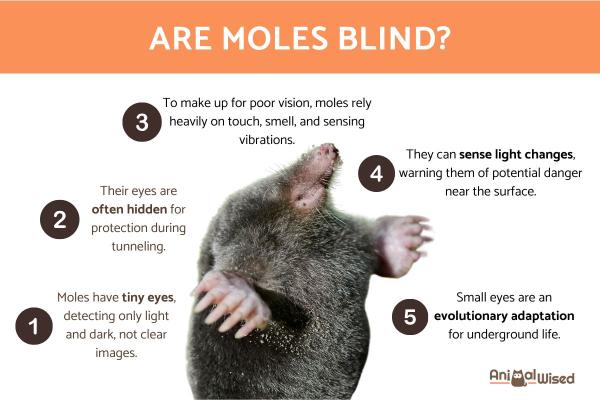
When you picture life underground, moles are likely one of the first animals that come to mind. Their unique, shovel-like paws and extensive burrowing habits are certainly memorable. A common question, however, is whether these subterranean mammals are truly blind. While many people believe moles are sightless, the reality is more complex and quite fascinating.
In this article, we will explore whether moles are really blind, as well as the anatomy of their eyes, their sensory adaptations, and more.
What are moles and their characteristics
Moles are small, subterranean mammals that live in North America and Eurasia, where they create extensive underground tunnel systems. There are about 42 species of moles worldwide, with most belonging to the Talpidae family.
These creatures spend almost their entire lives underground, which keeps them safe from birds and other predators.
When it comes to dining, moles prefer worms above all else. In fact, they have developed a clever and unique strategy, they bite the worms and store them alive in their tunnels for later consumption. This "pantry" system supplements their diet of insects, grubs, and other small soil-dwelling creatures.
You'll rarely spot a mole above ground. When they do venture to the surface, it's usually to explore new territory or hunt specific insects they cannot find in their tunnels. This occasional emergence is brief, as they quickly return to the safety of their underground network.
What are the characteristics of moles?
Living almost entirely beneath the soil, these small mammals have developed unique physical and behavioral traits that make them perfectly suited for tunneling, hunting, and navigating their dark, subterranean environment. Here's a closer look at some of those features.
- They have shovel-like front paws with strong claws to help moles dig through soil quickly and create tunnel networks.
- They have fur that lies in any direction, which lets moles move forward and backward in tunnels without getting stuck in soil.
- They have long snouts that work as navigation tools, detecting prey and obstacles in darkness.
- The cylindrical shape of their bodies is perfectly suited for squeezing through narrow passages and efficiently moving soil to construct their underground dwellings.
- They lack external ears, instead, they have tiny openings covered with fur. This helps them hear underground vibrations and movements really well.
- They are incredibly strong. They can push up to 40 times their own body weight, which helps them move a lot of dirt.
- They have a unique sleep cycle that differs from most animals that sleep at night. Likewise, they work and sleep in cycles of about 4 hours, which fits their constant underground activity.
- They have specialized lungs that can handle higher carbon dioxide levels than most mammals.
- Their sensitive whiskers help them detect movements and vibrations through soil.
- They have specialized kidneys that efficiently reuse water in dry underground conditions.
- Their thick skin around the snout and feet resists damage from constant contact with soil.
- Their low metabolic rate helps save energy while maintaining the strength needed for digging.
Curious about what else makes these subterranean mammals so special? Explore our collection of mole facts that will change how you see these garden visitors

Are moles blind?
Moles aren't completely blind, but their vision is limited. Their eyes are extremely small (often just 1mm in diameter) and barely visible to the naked eye, even up close.
What are mole eyes like?
Despite their tiny size, mole eyes have a simple structure with basic light-detecting cells. They can distinguish between light and dark, providing enough vision to sense when they might be approaching the surface or when a predator's shadow passes overhead.
Their eyes lack many features found in above-ground animals, such as complex focusing mechanisms or cone cells for color vision. These basic eyes are also well-protected, covered by thick fur and a tough skin layer, almost like they're closed up tight.
Why are mole eyes so small?
Several theories explain why mole eyes are so tiny:
- Since moles live underground where it's dark, their eyes likely got smaller over time because they didn't need them for survival.
- Small eyes are less likely to get hurt in the dirt and tunnels where moles spend most of their time.
- The resources that would go to developing complex eyes are instead directed toward enhancing more useful senses for underground life, like touch and smell.
Differences between species:
While all moles share these general features, their ability to see varies a lot between different mole species.
- European mole (Talpa europaea): has functional but extremely small eyes covered by thin skin and fur, but can still detect light changes.
- Star-nosed mole (Condylura cristata): has eyes so tiny they're virtually useless, compensating with their star-shaped nose that contains over 25,000 sensory receptors.
- Mediterranean mole (Talpa caeca): has eyes that disconnect from their optic nerves during development, rendering them completely blind as adults.
- Eastern mole (Scalopus aquaticus): retains slightly better vision than some other species, though still extremely limited.
For certain mole species, like the Mediterranean mole, scientifically known as Talpa caeca, a unique developmental process occurs where the optic nerves sever, leaving the adult moles entirely blind.

How do moles sense their environment?
With such poor vision, moles have evolved alternative sensory systems to navigate their dark underground world. While their tiny eyes provide minimal visual information, their bodies have developed features that create a rich sensory picture of their surroundings without relying on sight.
Moles rely heavily on their sensitive whiskers and specialized touch receptors to navigate their dark tunnels. Their snouts contain thousands of Eimer's organs, the small dome-shaped structures packed with nerve endings that detect the slightest touch. These organs are especially abundant in star-nosed moles, which have about 25,000 of these sensors on their star-shaped nose alone. As moles move through tunnels, their whiskers and snout constantly brush against the walls, creating a detailed tactile map of their surroundings.
Moles can detect subtle vibrations that travel through soil, helping them sense approaching predators, potential mates, or prey movements. Their front paws are also sensitive to ground vibrations, acting like secondary sensing devices. Moles can detect changes in air pressure and temperature within their tunnel systems, which helps them identify tunnel intersections, chambers, and exits.
They also use Earth's magnetic field as a navigational aid, with research suggesting they have magnetite particles in their cells that function like tiny compasses.
A mole's sense of smell is extraordinarily powerful, playing a crucial role in locating food. Their elongated snouts contain large olfactory bulbs that can detect earthworms and insects from several inches away through soil. This keen sense helps them create efficient hunting paths through their territory.
While lacking external ears, moles have good hearing ability specifically tuned to the low-frequency sounds and vibrations that travel through soil. They can hear the movement of worms and insects, and distinguish between threatening and non-threatening sounds in their environment.
If you found mole adaptations interesting, you'll be amazed by how other underground dwellers have evolved to thrive beneath our feet. Check out our in-depth exploration of earth's hidden inhabitants.
If you want to read similar articles to Are Moles Really Blind?, we recommend you visit our Facts about the animal kingdom category.
- Britannica. (n.d.). Mole: Mammal. Encyclopedia Britannica. Retrieved from https://www.britannica.com/animal/mole-mammal
- Osborne, H. (2015, August 31). Moles: Facts about the underground mammals. Live Science. Retrieved from https://www.livescience.com/52297-moles.html
- Toms, M. (2022, January 26). Specieswatch: The secret lives of moles. The Guardian. Retrieved from https://www.theguardian.com/world/2022/jan/26/specieswatch-the-secret-lives-of-moles